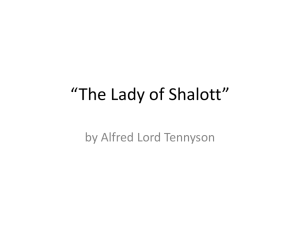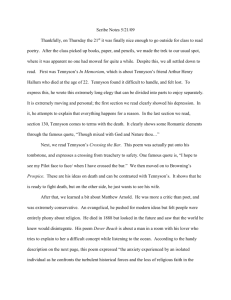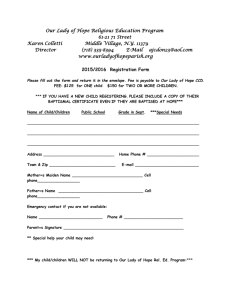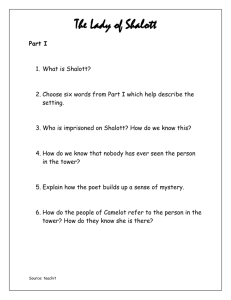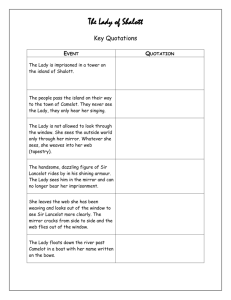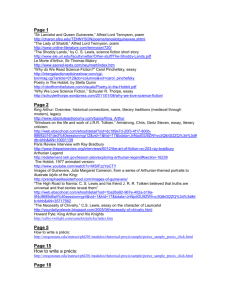The Lady of Shalott
advertisement
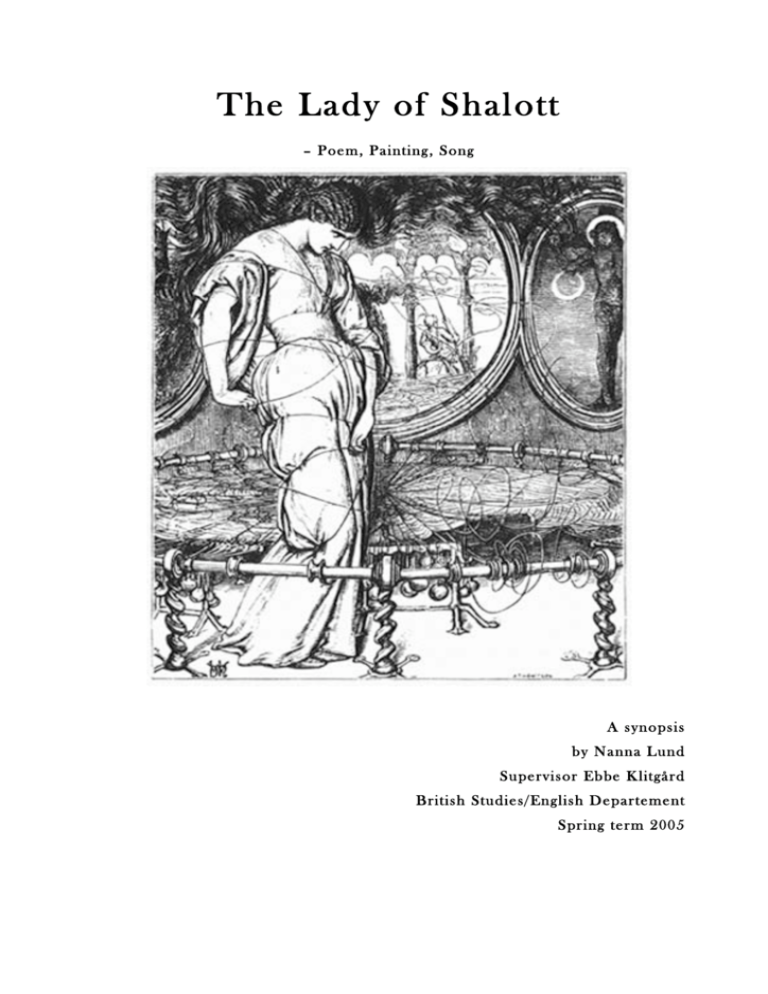
The Lady of Shalott – Poem, Painting, Song A synopsis by Nanna Lund Supervisor Ebbe Klitgård British Studies/English Departement Spring term 2005 Foreword The critical production on Tennyson is enormous and awe-inspiring; among his critics were artists like W. H. Auden who did not show unqualified enthusiasm, T. S. Eliot who found that Tennyson was a master of meter and sound though lacking the ability to tell a narrative (Killham, 1969:207-8) and even Wordsworth who allegedly wrote to Tennyson that Tennyson had exceeded him by writing the pastoral Dora (Henderson, 1978:54) – and of course the scholarly production is massive as is the general interest if the internet is any sort of indication; a google search for ‘tennyson’ and ‘poet’ yields 172.000 hits. It would be rather preposterous to claim to be able to contribute new insights in the study of Tennyson’s works on this background and my motivation is another: I have always enjoyed reading Tennyson and this is the perfect opportunity to work with one of my personal favorites without having to produce a Introduction to problem ‘The Lady of Shalott’ is of course a poem by Tennyson, first published in “Poems” in 1833 and then revised and published again in 1842, but the poem has served as inspiration for other artists as well. According to Péteri, the Pre-Raphaelite painters produced seven pictures inspired directly by the ‘The Lady’ if one counts Elisabeth Siddal’s drawing as well as the illustrations for Moxon’s illustrated Tennyson collection. Tennyson and the Pre-Raphaelites share a highly aesthetic expression; I think that most people today would agree that both poems and paintings are appealing or even beautiful at a first glance, and this can be something of a handicap to modern audiences as strong currents in our own time seem to expect substantial art to be unaesthetic. It is also worth noticing that in the history of painting, the end of the PreRaphaelite era inaugurated the age of aestheticism and with it the view that the appreciation of art took a ‘connoisseur’ with “…an immense store of obscure knowledge” (Hilton, 1970:208) whereas Tennyson and to a certain extent also the paintings inspired by him enjoyed a wide popularity. 2 Still; the contemporaries of Tennyson and The Pre-Raphaelite Brotherhood did not always find their work appealing, beautiful or substantial - indeed they were subjected to heavy criticism as well as praise1. Yet both Tennyson and the painters who were inspired by his work had more purpose to their art than empty aestheticism, their aestheticism was full of meaning; religious, moral, instructive and personal, even though Tennyson’s point of departure was not clearly stated like the Pre-Raphaelite Brotherhood’s,2 for Tennyson’s ‘purpose’ one have to turn firstly to his poems. In relation to The Lady of Shalott, the view seems widely held that the poem has qualities even though there are rather diverse ideas of what these qualities consist of - in the words of Petéri; Tennyson’s contemporaries at first were a little baffled over what ‘The Lady…’ was about (Petéri paragraph 1)3. Indeed Leigh Hunt found it successful as “…a series of long-drawn musical reiterations” (Jump, 1967:131), John Stuart Mill thought that ‘The Lady…’ proved Tennyson’s “…command over the materials of outward sense for the purpose of bodying forth states of feeling” (Jump, 1967:95). Gerard Manley Hopkins saw ‘The Lady…’ as Tennyson “…rhyming pure and simple imagination, without afterthought” (Jump, 1967:334) I find the poem enigmatic as well but that probably is not the worst motivation for a reading. Many of the scholarly analyses focus on the essence of the curse laid on the Lady, whether it is perceived as the inability of the artist to represent reality or the artist’s flight from reality or the fatal consequences for a woman who acts against the rules of proper behavior by pursuing the man she has fallen in love with. I hope to be able to take a different direction in my reading: In my reading I should like to focus on what I think is a play upon the ballad form and ambience of the poem, hereunder the significance of Lancelot’s remark in the final stanza and the behavior of the inhabitants of Camelot, as well as a suggestion of the possible convergence of the character of the Lady, the poet and the product of her work. I should also like to offer an interpretation of what it is the Lady does when she weaves, as it might be 1 The Times wrote of the brotherhood’s “…absolute contempt for perspective and the known laws of light and shade, an aversion to beauty in every shape, and a singular devotion to the minute accidents of the subjects.” In a review of their contribution to the 1851 Royal Academy Exhibition (The Times, quoted in Sullivan, 1996:28). In a review of Tennyson from 1832 in Blackwood’s Edinburgh Magazine of ‘Poems, Chiefly Lyrical’ John Wilson under his pen-name Christopher North wrote: “At present he has small power over the common feelings and thoughts of men. His feebleness is distressing at all times when he makes an appeal to their ordinary sympathies. And the reason is, that he fears to look such sympathies boldly in the face, - and will be – metaphysical. (Christopher North, in Jump, 1967:52) 2 William Rossetti described the aims of the brotherhood as 1) To have genuine ideas to express; 2) To study Nature attentively, so as to know how to express them; 3) To sympathize with what is direct and serious and heartfelt in previous art, to the exclusion of what is conventional and self-parading and learned by rote; and 4) Most indispensable of all, to produce thoroughly good pictures and statues (Sullivan, 1996:6) 3 As this is a document from the Internet without pagination, references are given in this way. 3 understood through the death of the Lady and the effect of it on her surroundings. This reading will aim at answering the following: Question/problem Based in a close reading of Tennyson’s poem “The Lady of Shalott” along the lines presented above and subsequent readings4 of the paintings5 by William Holman Hunt and John William Waterhouse, painted around 1890 and 1888 respectively, I am going to examine how they interpret the poem, especially if and how they reflect the paradox of the form presented by the poem and what role they ascribe the Lady. A Contemporary Interpretation of the Poem/Another Angle I am not sure whether this addendum to the investigation would be methodologically sound as I have no special musical knowledge but the result of the analysis could be given a further perspective by this: As an example of yet another artist who has been inspired by Tennyson, the Canadian singer Loreena McKennitt in 1991 sent out a CD featuring the poem set to music6 (McKennitt, 1991:track 4) I find the song quite beautiful but it is also amusing that Tennyson’s poem which adapted medieval imagery, parts of which were set in what was considered ancient times in the middle ages (the Arthurian legends) and a ballad form. - Has in its turn served as inspiration for painters who tried to reform painting by getting their inspiration from “Pre-Raphaelite” painters and contemporary literary works (Hilton, 1970:chapter two) – and that the same poem now serves as the lyrics to a song with a clearly Celtic folk music inspiration. In a way the poem has come full circle, now actually becoming a ballad. Of course this rendering also represents a reading of the poem and I should like to compare it to the other. Introduction to Tennyson and Tennyson c ritique This part would present Tennyson in more detail, some biographical notes according to Henderson and others, also, perhaps a very brief introduction to the Victorian period but not much. Also, based in Henderson, something on the author’s work process in relation to 4 Of course thorough image and music analysis demands a theoretical framework, what I suggest is a close reading or careful scrutiny of the paintings and song without going in to technical considerations. 5 I will bring the pictures for the exam, they can also be seen at the web addresses given after the bibliography. 6 I do not think she was the first to do so, I have heard about an Israeli rock band from the seventies who had a song called The Lady of Shalott but I have not been able to find their song. Actually the poem seem to invite attempts at singing it so there might be several songs but Loreena McKennitt’s version is probably the best known. If possible, I will bring the song for the exam. 4 revisions of his own earlier work because the earlier edition of the poem might be useful in the analysis. A survey of the major trends in Tennyson-critique especially with regards to ‘The Lady of Shalott” would also be a part of this section. A Reading of ‘The Lady of Shalott’ As described above I find there is a ‘play’ or build-in contradiction with regards to the ballad form and the romance7 elements in the poem when they are related to the action of the poem. The reader’s expectations are not gratified; the ending is quite different from a ‘proper’ romance or ballad ending. Part of the reading would be concerned with locating romance elements and to define when the poem strays from the romance mould and of course offer a possible interpretation of these instances. The function of the Lady’s activity, her weaving, imply many different things, here the focus would be on The Lady as upholding the world and as a seer and possibly as an offering (?) herself, there is a suggestion of the outside world unravelling as the Lady stops her re-creating work by the loom. This strain of analysis demands close scrutiny of the images of the Lady’s initial state, the mirror, the loom and web and of the song, death and arrival in Camelot. Also I would offer an explanation for the author’s choice of Lancelot as the disruptive knight (apart from the fact that he is the only knight of The Round Table who rhymes with ‘Camelot/Shalott’) - This might or might not be applicable to a further analysis of the Lady as the poet/poem but this is highly tentative. Introduction to the Pre-Raphaelites and presentation of paintings A brief presentation of the background and goals of the Pre-Raphaelite Brotherhood giving special attentions to the painters whose pictures are used for analysis. A minimum of two seems sensible with regards to being able to present some different perceptions of the poem. William Holman Hunt’s ‘Lady’ painted between 1886 and 1905 and one of William Waterhouse’s three ‘Ladies’ namely the one painted in 1888 depicting the Lady as she sits in the boat, ready to leave for Camelot, would probably be good choices as they are very different. 7 A definition of romance would be necessary for further analysis. 5 A Reading of the Paintings Waterhouse’s ‘Lady’ is shown in the moment before she begins her journey towards Camelot, she sits in the boat, holding the chain in her hand and she is calm, maybe contemplating, maybe “in a trance”. She has brought the web or tapestry with her, a detail not mentioned in the poem. The boat also holds a crucifix and three candles and these details would all be included in a reading of the painting. The rendering of the surroundings is also interesting: The rotting reeds in the foreground and the dim light and dark colours of the trees and grass all add to the dark mood of the painting. Hunt’s ‘Lady’ is highly dramatic; she is depicted at the moment of leaving the loom. The loom itself is very strange, circular and horizontal as a spiders web and the whole air of the room is charged with electricity or magic, the Lady’s hair flies about her head and she looks like it takes physical strength for her to break free. The painter has included various objects not mentioned in the poem, the significance of these would have to be investigated. For instance the background includes biblical images and in the foreground a pair of doves fly by. Presentation of the Song and a few remarks towards a reading This is not intended to be a major part; still I find the connection interesting. The ‘sound-image’ of the song is dominated by vocal, violin, harp and guitar. The instruments are all found in traditional Irish music and this is what the sound of the instruments suggests. In the background a soft symphonic keyboard add something both modern and dreamy though it sometimes become flute-like, again emphasizing the kinship with traditional Irish music. The vocal style also suggests traditional folk music and an inspiration in the phrasing from 'sean nós' singing8. In this interpretation the poem has become a folk ballad with a bit of a new age flavour. It could be said to be reduced to “a lovely face” without much behind it. 8 A style of unaccompanied song in traditional Irish music. 6 Bibliography Abrams, M. H. Gen. ed. 2000 The Norton Anthology of English Literature vol. 2, seventh edition. New York and London: W.W. Norton and Company Henderson, Philip 1978 Tennyson, Poet and Prophet. London and Henley: Routledge & Kegan Paul Ltd Hilton, Timothy 1970 The Pre-Raphaelites. London: Thames and Hudson Ltd Hobson, Anthony 1989 J W Waterhouse. London: Phaidon Press Limited Jump, John D. ed. 1967 Tennyson, The Critical Heritage. U.K: Routledge & Kegan Paul Limited/U.S: Barnes & Noble Killham, John ed. 1960 Critical Essays on the Poetry of Tennyson. London: Routledge & Kegan Paul Ltd McKennitt, Loreena 1991 The Visit, track 4 The Lady of Shalott. Quinlan Road 7 Mariotti, M. 2004 The Lady of Shalott: Pre-Raphaelite Attitudes Toward Woman in Society. http://www.victorianweb.org/painting/prb/mariotti12.html 02/06/05 Péteri, Éva 2001 Tennyson and His Pre-Raphaelite Critics, Pre-Raphaelite Interpretations of Tennyson’s “The Lady of Shalott”. http://www.insitegrafx.hu/theanachronist/docs/Anach_0003/Peteri.doc 02/06/05 Saunders, Corinne ed. 2004 A Companion to Romance, From Classical to Contemporary. Oxford: Blackwell Publishing Sullivan, K. E. 1996 Pre-Raphaelites. London: Brockhampton Press Thomson, Alastair W. 1986 The Poetry of Tennyson. London and the USA: Routledge & Kegan Paul Wright, Jane 2004 A Reflection on Fiction and Art in “The Lady of Shalott” http://80-muse.jhu.edu.p-p-f.proxy.kb.dkjournals/victorian_poetry/v041/. 02/06/05 (This article was accessed through Det kongelige bibliotek – electra access is necessary to follow this link) Hunt’s painting: www.mitene.or.jp/˜t-square/kaleidoscope/mckennitt/shal_4.htm A study for the painting, giving a good impression of the general design can be seen at: www.wwnorton.com/nael/victorian/topic_3/illustrations/imshalott1.htm and on the title page Waterhouse’s painting: www.essentialart.com/acatalog/john_william_waterhouse_prints_the_lady_of_shalott.html 8
